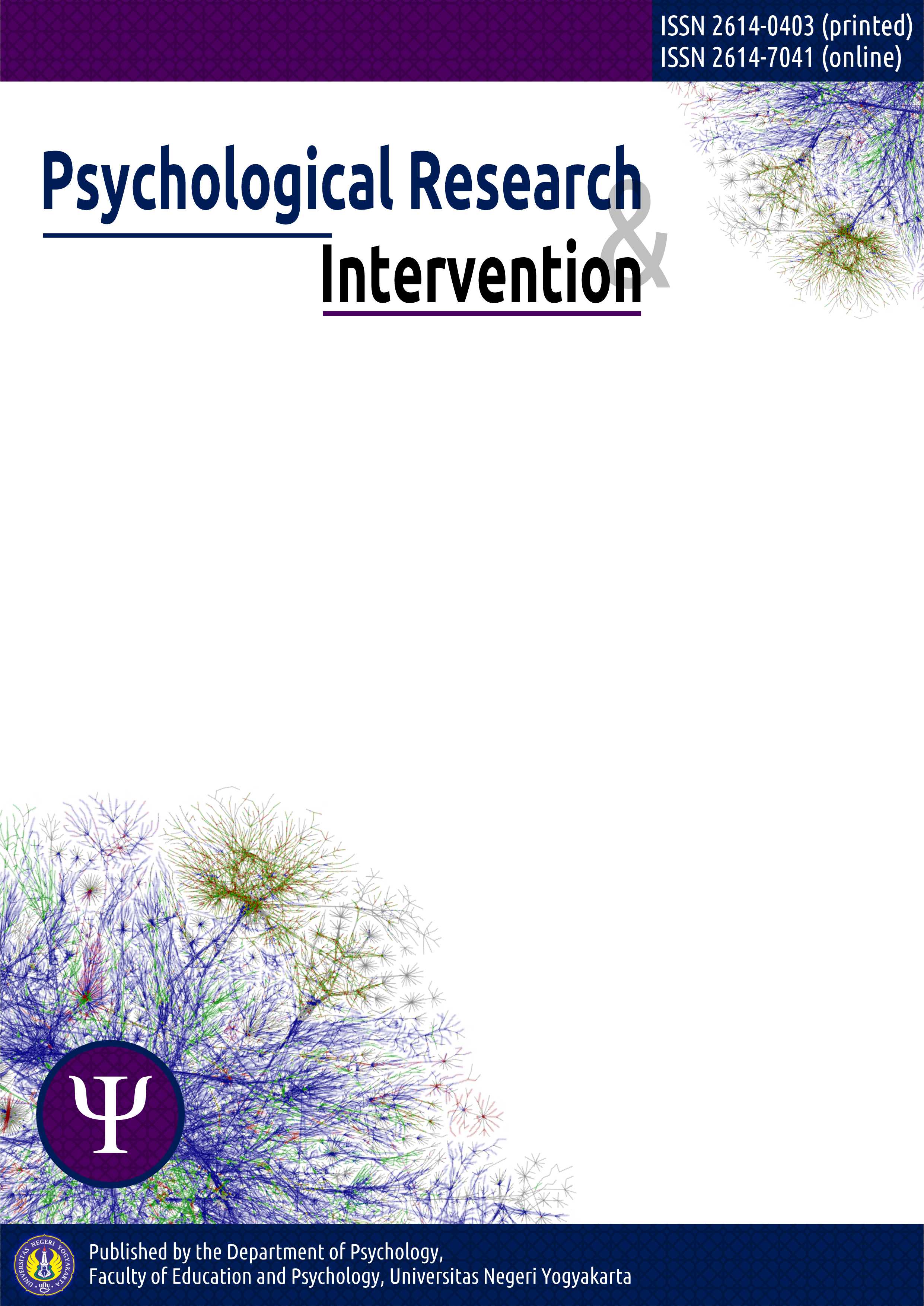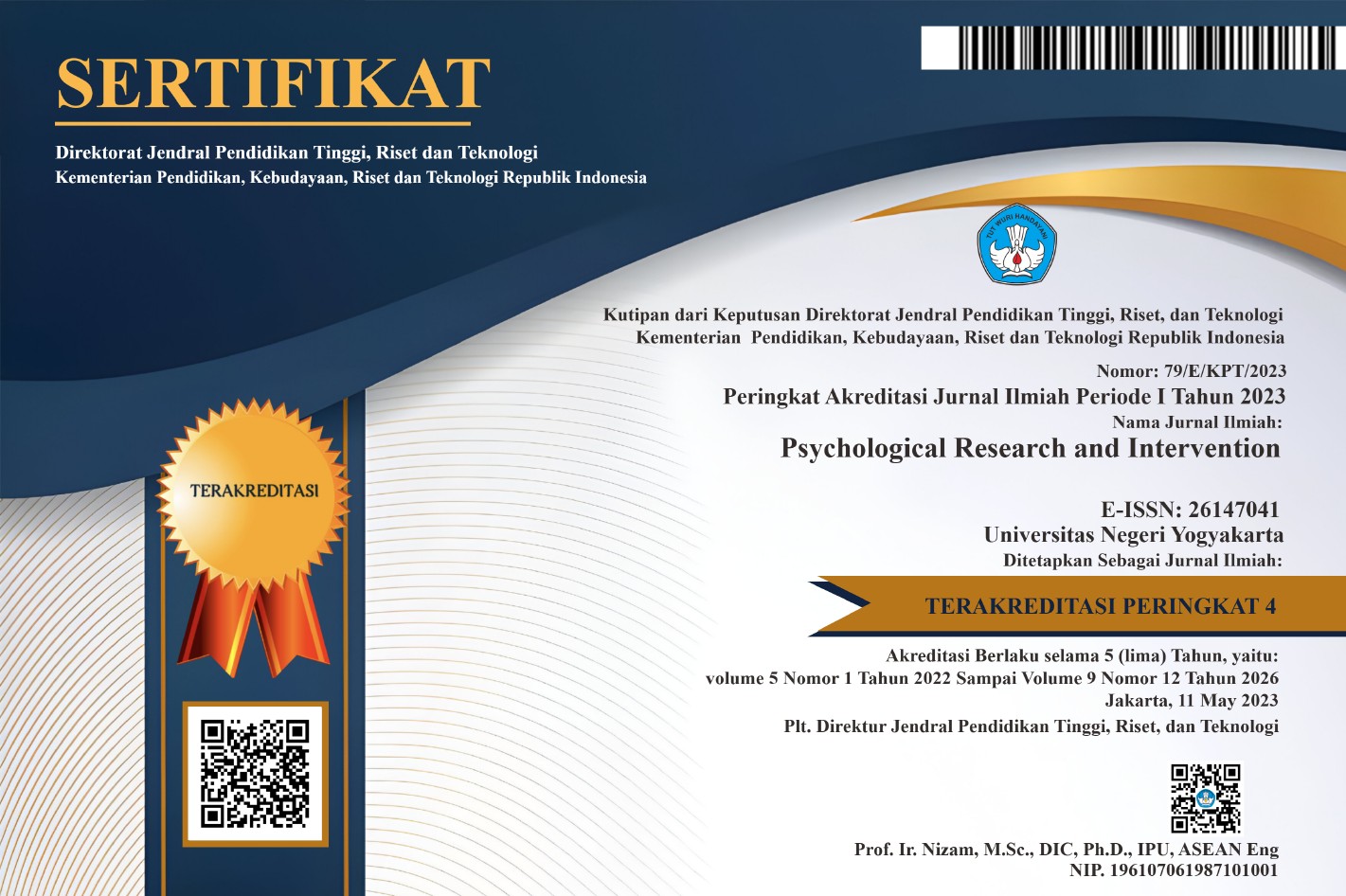The influence of occupational safety and health on work engagement
DOI:
https://doi.org/10.21831/pri.v5i1.50823Abstract
This study is conducted based on the phenomenon of low work engagement in companies, the possible one is due to lack of application Occupational Safety and Health (OSH). This paper aims to determine the effect of Occupational Safety and Health (OSH) on work engagement on employees. This research uses a quantitative approach to the type of ex post facto.The sampling technique in this research is purposive sampling and the samples in this research is employee of PT Telkom Access Pugeran Yogyakarta branch, with the scale of 96 employees, 67 male employees and 29 female employees. The instruments of this research used two psychological scales, namely OSH scale and work engagement scale. Analyzed data by using descriptive analysis and simple linear regression analysis. The results of the regression analysis score are 0,000 < 0,05, it can be concluded that there is a positive influence of Occupational Safety and Health (OSH) on work engagement. The coefficient determination or R Square is 0,498 or 49,8%, meaning that 49,8% of employees work engagement is influenced by OSH, while the remaining 50,2% is influenced by other factors not examined in this study.References
Anoraga, P. (2005). Psikologi Kerja. Jakarta: Rineka Cipta.
Ayim Gyekye, S. (2005). Workers' perceptions of workplace safety and job satisfaction. International Journal of Occupational Safety and Ergonomics, 11(3), 291–302. https://doi.org/10.1080/10803548.2005.11076650
Ayu Er. Meytha Gayatri, I. (2015). Hubungan keselamatan dan kesehatan kerja (K3) dengan kinerja karyawan pada PT. UOB Indonesia cabang bengkulu. EKOMBIS REVIEW: Jurnal Ilmiah Ekonomi Dan Bisnis, 3(2), 185–196. https://doi.org/10.37676/ekombis.v3i2.145
Azwar, S. (2018). Metode Penelitian Psikologi Edisi III. Pustaka Pelajar.
Bakker, A. B., & Albrecht, S. (2018). Work engagement: current trends. Career Development International, 23(1), 4–11. https://doi.org/10.1108/CDI-11-2017-0207
Bakker, A. B., & Leiter, M. P. (2010). Work engagement: A Handbook of Essential Theory and Research. Arnold B. Bakker & Michael P. Leiter (Ed.). New York: Psychology Press. https://dx.doi.org/10.1111/j.17446570.2011.01242_2.x
Bazzoli, A., Curcuruto, M., Morgan, J. I., Brondino, M., & Pasini, M. (2020). Speaking up about workplace safety: An experimental study on safety leadership. Sustainability (Switzerland), 12(18), 1–22. https://doi.org/10.3390/SU12187458
Christina, W. Y., Ludfi, D., & Thoyib, A. (2012). Pengaruh budaya keselamatan dan kesehatan kerja (K3) terhadap kinerja proyek konstruksi. Jurnal Rekayasa Sipil, 6(1), 83–95.
Cooklin, A., Joss, N., Husser, E., & Oldenburg, B. (2017). Integrated approaches to occupational health and safety: A systematic review. American Journal of Health Promotion, 31(5), 401–412. https://doi.org/10.4278/ajhp.141027-LIT-542
Dantes, N. (2012). Metode Penelitian. ANDI.
Decuypere, A., & Schaufeli, W. (2020). Leadership and work engagement: Exploring explanatory mechanisms. German Journal of Human Resource Management, 34(1), 69–95. https://doi.org/10.1177/2397002219892197
Demir, P., Gul, M., & Guneri, A. F. (2020). Evaluating occupational health and safety service quality by SERVQUAL: a field survey study. Total Quality Management and Business Excellence, 31(5–6), 524–541. https://doi.org/10.1080/14783363.2018.1433029
Empati, J., Aidina, N. R., & Prihatsanti, U. (2018). Hubungan antara kepercayaan terhadap pemimpin dengan keterikatan kerja pada karyawan PT Telkom Witel Semarang. Empati, 6(4), 137–142.
Esmaeili, N., & Bamdad Soofi, J. (2021). Expounding the knowledge conversion processes within the occupational safety and health management system (OSH-MS) using concept mapping. International Journal of Occupational Safety and Ergonomics, 0(0), 1–27. https://doi.org/10.1080/10803548.2020.1853957
Etikariena, A. (2019). Perbedaan perilaku kerja inovatif berdasarkan karakteristik individu karyawan. Jurnal Psikologi, 17(2), 107. https://doi.org/10.14710/jp.17.2.107-118
Firnanda, D. Y., & Wijayati, D. T. (2021). Pengaruh perceived organizational support, self efficacy dan lingkungan kerja terhadap employee engagement karyawan PT. Pesona Arnos Beton. Jurnal Ilmu Manajemen, 9(3), 1076–1091. https://doi.org/10.26740/jim.v9n3.p1076-1091
Ghozali, I. (2018). Aplikasi Analisis Multivariate dengan Program IBM SPSS 2 Edisi 9. Undip.
Ju, B., & Li, J. (2019). Exploring the impact of training, job tenure, and education-job and skillsjob matches on employee turnover intention. European Journal of Training and Development, 43(3–4), 214–231. https://doi.org/10.1108/EJTD-05-2018-0045
Mathpati, C. (2012). Employee engagement: A leader's priority. International Journal of Research in Marketing, 1(2), 1-8.
Maula, R. R., Hidayatullah, M. S., & Yuserina, F. (2019). Pengaruh Persepsi Kesehatan dan Keselamatan Kerja ( K3 ) Terhadap Keterikatan Kerja Karyawan Teknik Lapangan di PT . Haleyora Powerindo Banjarmasin. Jurnal Kognisia, 2(1), 78–84. https://ppjp.ulm.ac.id/journals/index.php/kog/article/view/1612
Mekkodathil, A. E.-M.-T. (2016). Occupational Injuries In Workers From Different. International Journal of Critical Illness and Injury Science, 6(1), 25 doi: 10.4103/22295151.177365.
Min, J., Kim, Y., Lee, S., Jang, T. W., Kim, I., & Song, J. (2019). The Fourth Industrial Revolution and Its Impact on Occupational Health and Safety, Worker's Compensation and Labor Conditions. Safety and Health at Work, 10(4), 400–408. https://doi.org/10.1016/j.shaw.2019.09.005
Nwachukwu, C. C. (2007). Management Theory and Practice. Africana First Publishers Limited, Nigeria, pp.
Razak, N. A. (2016). Measuring Reliability and Validity Instruments of Work Environment Towards Quality Work Life. Procedia Economics and Finance, 37(16), 520-528. https://doi.org/10.1016/s2212-5671(16)30160-5.
Robijn, W., Euwema, M. C., Schaufeli, W. B., & Deprez, J. (2020). Leaders, teams and work engagement: a basic needs perspective. Career Development International, 25(4), 373–388. https://doi.org/10.1108/CDI-06-2019-0150
Rofiana. (2014). Analisis Pengaruh Locus of Control dan Lingkungan Kerja terhadap Kinerja Pegawai dengan Self Efficacy sebagai Mediasi. Jurnal Telaah Manajemen, 11(1), 145–157.
Saks, A. M. (2006). Antecedents and consequences of employee engagement. Journal of Managerial Psychology 21(7), 600-619. https://dx.doi.org/10.1108/0268394061069016
Schaufeli, W. B., Salanova, M., Gonzalez-Roma, V., & Bakker, A. B. (2002). The measurement of engagement and burnout: A two sample confirmatory factor analytic approach. Journal of Happiness Studies, 3(1), 71-92. https://dx.doi.org/10.1023/A:101563093032
Schaufeli, W. B. (2006). The Measurement of Work Engagement With a Short Questionnaire: A Cross-National Study. Educational and Psychological Measurement, 66(4), 701–716. https://doi.org/10.1177/0013164405282471.
Schaufeli, W. B. (2011). Work Engagement: What do we know? International OHP Workshop, December, 1–60.
Sugiyono. (2018). Metode Penelitian Kuantitatif Kualitatif dan R&D. ALFABETA.
Suma'mur. (2009). Hiegiene Perusahaan dan Keselamatan Kerja. CV Sagung Seto.












